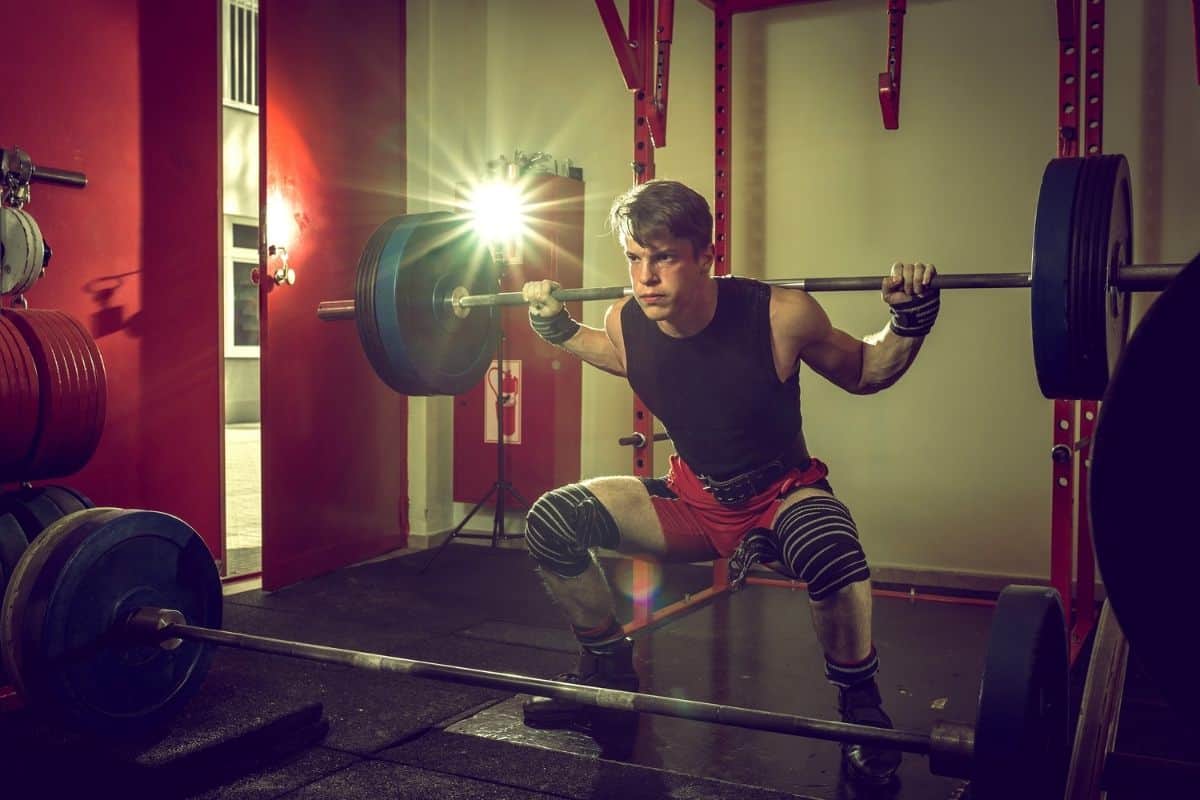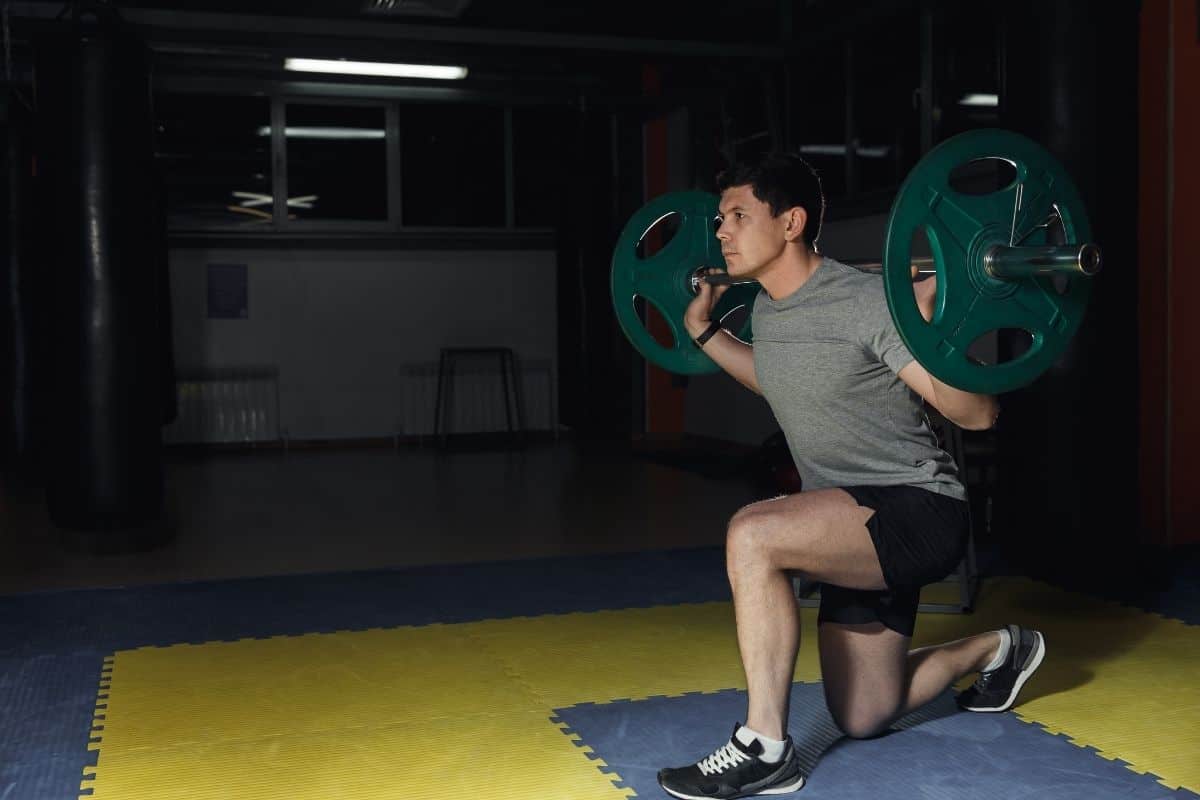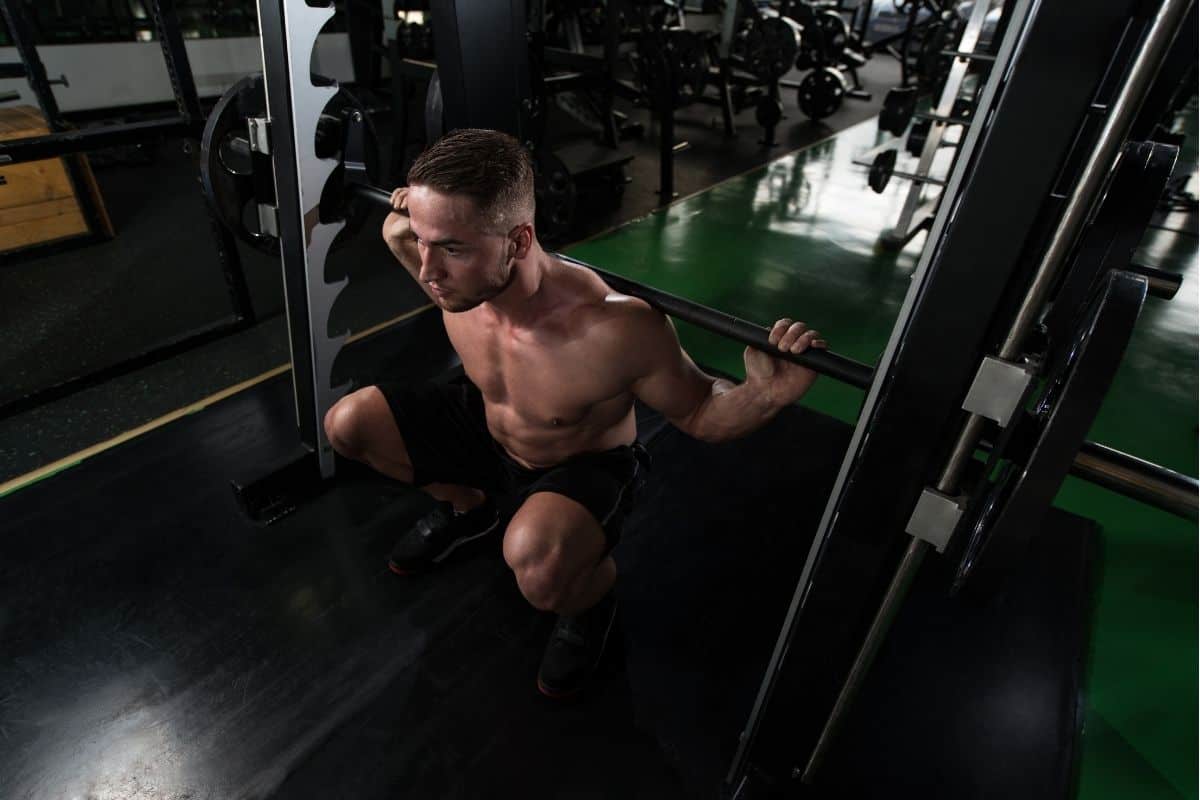You most probably scooch front and back when it comes to squats. Well, there is a list of great barbell squat variations to choose from, and each variation is different and has its own characteristics. So, based on your fitness level and goal, you can do some or all of them throughout the week or month.
Below is the list of thirteen different barbell squat variations you’ll see in this article:
- Back Squat
- Front Squat
- Sumo Squat
- Box Squat
- Landmine Squat
- Split Squat
- Zercher Squat
- Overhead Squat
- Hack Squat
- Pin Squat
- Squat Thruster
- Squat Clean
- Anderson Squat
You can include some of these squat variations into your training program to hammer your quads, glutes, and hams and build the brawniest legs.
The Best Barbell Squat Variations for Strong Legs and Glutes
1. Barbell Back Squat

About Exercise
- Main Focused Muscles: Quads, Glutes, Abs, and Hamstrings
- Exercise Difficulty: Intermediate
- Mechanics: Compound
- Primary Goal: Strength and Mass
Benefits
- It strengthens multiple muscles at once, particularly the quads, and helps increase the thigh size and shape.
- It is one of the three big lifts in Powerlifting, great for increasing strength and stability.
Disadvantages
- Incorrect form or heavy load increases the risk of knee injuries and lower back strain.
- A back squat isn’t easy to execute as it requires positioning your feet, torso, knee, and hip in the right position.
How-to Perform a Back Squat
- Put the appropriate weight into the bar and place it on the back of your shoulders.
- Stand tall in the shoulder-width stance with your back straight, chest up, and core tight.
- Pushing your hips back, bend your knees to squat down until your thighs parallel the floor.
- Pressing your feet onto the floor, slowly return to the standing position.
Tips and Mistakes
- You should keep your knees slightly outward throughout the movement.
- Keep your chest up to avoid leaning too far forward because it can strain your lower back and shift the load to your knees.1 Myer, Gregory D et al. “The back squat: A proposed assessment of functional deficits and technical factors that limit performance.” Strength and Conditioning Journal vol. 36,6 (2014): 4-27. doi:10.1519/SSC.0000000000000103
- Ensure your knees do not excessively pass your toes while squatting down.
How to Program
- Lift heavy and keep the rep ranges 2-6 to maximize strength.
- Use light to moderate weights with medium rep ranges (6-15) to stimulate hypertrophy.
- You can also perform 15-30 reps at maximum heart rate to enhance your endurance and boost your athletic fitness.
2. Barbell Front Squat

About Exercise
- Target Muscles: Anterior Thigh
- Exercise Difficulty: Intermediate
- Mechanics: Isolation
- Primary Goal: Build Muscle and Helps Progress for the Back Squat
Benefits
- It engages more of your quads than the back squat, so consider this exercise for shaping your quadriceps.
- The front squat puts less stress on the knees and can be comfortable for people with knee problems, such as meniscus tears.2 Gullett JC, Tillman MD, Gutierrez GM, Chow JW. A biomechanical comparison of back and front squats in healthy trained individuals. J Strength Cond Res. 2009 Jan;23(1):284-92. doi: 10.1519/JSC.0b013e31818546bb. PMID: 19002072.
Disadvantages
- A front squat can be uncomfortable for people with limited shoulder mobility because it requires placing the bar on your shoulders and holding it under your palms; so for this, you have to bring your elbows against your body and upper arms parallel to the floor, which requires flexibility in your shoulders.
- It is not as effective as a back squat for strength development.
How to Perform a Front Squat
- Put the loaded bar on the front of the shoulders and stand straight in the shoulder-width stance.
- Keep your back straight and chest up, and perform a squat until your thighs are parallel to the floor.
Tips and Mistakes
- Keep your torso vertical and core tight throughout the squat.
- Squat down as low as possible and use your feet to return to the upright position.
- Ensure your toes point slightly outward and your knees do not go beyond your feet while squatting down.
How to Program
Perform this exercise when you want to focus on your anterior thigh and build firm legs. You can do three to four sets of 8 to 20 reps. Start with light weights and perform around 20 reps to stimulate your quad muscles, and then put some plates after each set to challenge your strength further.
3. Barbell Sumo Squat

About Exercise
- Target Muscles: Adductors, Outer Quads, and Glutes
- Exercise Difficulty: Intermediate
- Mechanics: Compound
- Primary Goal: Strength and Mass Gain
Benefits
- The sumo squat reinforces the inner and lateral thigh muscles and helps build brawnier legs.3 Coratella, Giuseppe et al. “The Activation of Gluteal, Thigh, and Lower Back Muscles in Different Squat Variations Performed by Competitive Bodybuilders: Implications for Resistance Training.” International Journal of Environmental Research and Public Health vol. 18,2 772. 18 Jan. 2021, doi:10.3390/ijerph18020772
- It hip increases hip mobility and flexibility because of the wide stance.
- It also activates the glute muscles effectively and helps build a firm buttock.
- It is also easy on the lower back compared to shorter stance squats and can be used to build up strength for conventional back squats.
Disadvantages
- Like sumo deadlifts, sumo squats also have a limited range of motion. The wider stance shortens the length of the lift, which means your muscles won’t be under stress for long compared to the traditional squats.
- The wider stance squat requires more hip flexibility, making it unsuitable for people with hip issues.
How-to Perform a Sumo Squat
- Load the barbell according to your strength and place it on the back of your shoulders.
- Stand straight with your feet two times wider than hip-width and toes pointing out.
- Slowly push your hips back and bend your knees to squat down as low as possible.
- Push through your feet to return to the start.
Tips and Mistakes
- Keep your back straight and chest up during the entire movement.
- Hold your core tight to provide stability to the torso and lower back.
- Use the benefits of deep squats to feel the good stretch in your thigh muscles.
How to Program
The sumo squat is not as effective for quad muscle engagement as the front and back squats because it puts more emphasis on adductors and glutes. So, I suggest combining narrow and wide stance (Sumo) squats to build a solid lower body. You can do sumo squats once a week, three to four sets of 8 to 15 reps.
4. Barbell Box Squat
About Exercise
- Target Muscles: Quadriceps
- Exercise Difficulty: Beginner
- Mechanics: Isolation
- Primary Goal: Bolster Foundational Strength and Build Lean Mass
Benefits
- The box squat allows you to focus on your form and technique and helps you prepare for doing the other types of barbell squats.
- It also helps powerlifters practice squatting to the right depth.
Disadvantages
- It is good for progressing strength but is not entirely effective for muscle gain compared to other squat variations.
How-to Perform a Box Squat
- Place the bench or box behind near the rack and stand against it.
- Pick a loaded bar, place it on the back of your shoulder, and stand upright.
- Get into the squat position until your glutes touch the bench.
- Return to the start and repeat for the desired number of sets and reps.
Tips and Mistakes
- Use a box or bench of an appropriate height.
- Put on a belt to provide stability to your spine.
- You can also use the thick pad under the bar to avoid strain on the back of your shoulder.
How to Program
The box provides support and ensures you won’t fall, so you can lift heavy for strength, moderate for building muscle, and light for improving muscular endurance. So, depending on your goal, use this exercise to achieve desired results.
5. Barbell Landmine Squat
About Exercise
- Target Muscles: Thigh, Glutes, Abdominals, and Shoulders
- Exercise Difficulty: Intermediate
- Mechanics: Isolation
- Primary Goal: Build Muscle and Endurance
Benefits
- Landmine squats help balance hamstring to quadriceps activity and increase horizontal loading.4 Collins KS, Klawitter LA, Waldera RW, Mahoney SJ, Christensen BK. Differences in Muscle Activity and Kinetics Between the Goblet Squat and Landmine Squat in Men and Women. J Strength Cond Res. 2021 Oct 1;35(10):2661-2668. doi: 10.1519/JSC.0000000000004094. PMID: 34341315.
- It suits all fitness enthusiasts who want to build muscular and proportional legs without putting excessive stress on the lower spine and shoulders.
Disadvantages
- The landmine squat requires more space than the other variations.
- It doesn’t isolate the lower body as effectively as when you do the squats by placing the bar on your body.
How-to Perform a Landmine Squat
- Place one end of the bar in a corner to stay intact and insert the appropriate weights into another end.
- Stand in the shoulder-width stance so the weight is in between your legs.
- Lower yourself to grab the working end of the bar with your hands (at your chest height).
- Press your feet into the floor to stand straight until your knees are fully extended and your body slightly leaning forward. And from that position, do as many squats as possible.
Tips and Mistakes
- Slightly lean forward while maintaining a neutral spine before dropping into a squat.
- Use your heels to return to the standing position, feeling the full contraction in your quads.
- You can also squat deep to increase flexibility in your muscles.
How to Program
The landmine squat is great for warming your legs before training for a maximum of 1RM. So, I suggest performing two sets of 15-20 reps before back squats to increase muscle temperature and blood circulation around your legs.
6. Barbell Split Squat

About Exercise
- Target Muscles: Quads, Hamstrings, and Glutes
- Exercise Difficulty: Intermediate
- Mechanics: Compound
- Primary Goal: Build Stability, Endurance, and Muscle Mass
Benefits
- The barbell split squat is a compound exercise that bolsters the thigh and glutes simultaneously.
- It also allows you to focus more on your weaker leg and helps improve your strength imbalance and muscle symmetry.
- The split squat places tension on one foot at a time, helping you improve your mobility.
Disadvantages
- Not suitable for beginners.
- It can be riskier if you use a heavy load.
How to Perform a Split Squat
- Put the desired weight into the bar and hold it on the rear shoulder.
- Take a large step ahead and stand in the split stance with your back straight.
- Bend your knees to squat down until your rear knee touches the floor.
Tips and Mistakes
- Make sure your front knee doesn’t pass your toes.
- Ensure your front knee stays aligned with your ankle, not extending past your toes.
- Perform each rep with full control, feeling the contraction in your legs.
- Use your leading foot to return to the upright position.
How to Program
The split squat strengthens the lower body muscles differently than the other barbell squat types. So, you can pair this exercise with any squat variation to make a balanced leg workout routine.
7. Zercher Squat

About Exercise
- Target Muscles: Anterior Thigh
- Exercise Difficulty: Intermediate
- Mechanics: Isolation
- Primary Goal: Build Lean Mass
Benefits
- The Zercher squat engages muscles throughout the lower body, especially the quads.
- It also helps develop muscular forearms.
- The Zercher squat also improves functional fitness as it mimics some real-life activities, such as lifting a box or any object on your lower arms and taking it from one place to another.
Disadvantages
- The Zercher squats require holding the bar in the crooks of your elbows instead of on your shoulders, so if you have poor forearm strength, this isn’t for you.
- You also can’t lift heavy during this squat variation.
How to Perform a Zercher Squat
- Put the desired weight into the barbell and hold it in the crooks of your elbows.
- Stand upright with your back straight and core tight. That’s the starting position.
- Squat down as low as possible so your elbows can reach the inside of your knees.
- Push your feet into the floor to stand up back.
Tips and Mistakes
- Keep your chest up, back straight, and core tight throughout the squat.
- Ensure the bar is placed properly under the crook of your elbows.
How to Program
It primarily isolates the quadriceps and helps build proportional anterior thighs. You can also substitute this exercise with landmine or front squat because they work similarly. Perform three to four sets of 10-15 reps with a 2-minute rest between them. You can do it anytime during the leg workout.
8. Barbell Overhead Squat

About Exercise
- Target Muscles: Legs, Core, and Shoulders
- Exercise Difficulty: Advanced
- Mechanics: Compound
- Primary Goal: Endurance, Hypertrophy, and Mobility
Benefits
- The overhead squat engages the various muscles throughout the body, including the legs, glutes, abdominals, and shoulders.
- It improves balance as it requires you to hold the barbell overhead with straight arms.
- The overhead squat enhances functional strength because it involves movements we do in our daily lives, such as picking an object overhead.
Disadvantages
- It requires more control so you can hold the bar overhead; otherwise, it can be riskier than beneficial.
- You can only lift limited weight during this exercise.
How to Perform an Overhead Squat
- Grab a loaded bar with your hands slightly wider than a shoulder-width grip and hold it over your head with straight arms.
- Stand upright with your back straight. That’s the starting position.
- Squat down until your hips are parallel to the floor, and then return to the standing position to complete one rep.
Tips and Mistakes
- Do some dynamic stretches to activate your shoulder muscles before doing this movement.
- Keep your arms straight, core engaged, and chest up throughout the movement.
- Start with an empty barbell, then increase the desired weight.
How to Program
Overhead squats are great for functional athletes. However, all fitness enthusiasts who want to take up new challenges and try a variation of exercise can include the overhead squat in their training program. Aim for three to four sets of 10-20 reps.
9. Barbell Hack Squat
About Exercise
- Target Muscles: Quads and Hamstrings
- Exercise Difficulty: Intermediate
- Mechanics: Isolation
- Primary Goal: Build Muscle and Improve Mobility
Benefits
- The barbell hack squat activates the entire lower body muscle, especially the quadriceps. It is also called a reverse deadlift because of its position.
- It doesn’t require you to position the bar on your shoulder, which makes it a bit easier than the other variations.
Disadvantages
- It doesn’t allow for as deep a squat as other variations.
- Holding the barbell behind the body requires flexibility in your torso.
How-to Perform a Hack Squat
- Put the loaded bar on the floor and stand against it with your calves close to it, assuming a shoulder-width stance.
- Pushing your hips back, slightly bend your knees, and grab the bar with an overhand grip.
- Pressing your feet onto the floor, return to standing until your hips are fully extended.
Tips and Mistakes
- Start the squat by hinging at the hips before bending your knees.
- Start with an empty bar first, then increase the weight and focus on proper form over heavy weights to prevent injury.
How to Program
Shoot for 3 sets of 12-15 repetitions with moderate weights. Pair this exercise with back, split, and front squats to strike your entire legs effectively.
10. Barbell Pin Squat
About Exercise
- Target Muscles: Thighs and Glutes
- Exercise Difficulty: Intermediate
- Mechanics: Compound
- Primary Goal: Strength and Hypertrophy
Benefits
If you face challenges going deep during the standard squat, you may try the barbell pin squat. The barbell pin squat is an excellent way to improve your squatting and can be used as an accessory lift for the squat in powerlifting.
It is performed by setting the pin on the rack and allows you to customize the height depending on your height and goal.
Disadvantages
- The fixed racked height restricts the depth of the squat, reducing the range of motion compared to traditional squats.
- The pin squat requires access to a squat rack with adjustable safety pins, which are not readily available in most gyms.
How-to Perform a Pin Squat
- Set the pins at an appropriate height and put the desired weight into the barbell.
- Unrack the bar, hold it on the rear shoulder, and stand upright in the hip-to-shoulder width stance.
- Lower into a squat position until the barbell touches the pins.
- Return to the standing position in a quick manner, as fast as you can.
Tips and Mistakes
- Lower the weight in a controlled fashion to avoid bouncing the bar off the pins.
- Start with lighter weights to perfect your form before increasing the load.
How to Program
Aim for three sets of 10-15 reps. If you perform 15 reps easily, add more weight instead of increasing the number of repetitions.
11. Barbell Squat Thruster
About Exercise
- Target Muscles: Shoulders and Legs
- Exercise Difficulty: Intermediate
- Mechanics: Compound
- Primary Goal: Strength and Explosiveness
Benefits
- The barbell thruster is a high-intensity exercise that engages many muscles throughout the body, particularly the legs and shoulders, and helps increase endurance, strength, mobility, and speed.
- It also kindles plenty of calories quickly and enhances cardiovascular fitness.
- It combines squats and overhead presses, making it an excellent exercise for people with limited time.
Disadvantages
- It requires pressing the bar with explosive strength and can make you exhausted in a little time.
- The squat thruster is not for everyone, especially if you’re a beginner.
How to Perform a Squat Thruster
- Put the appropriate weight into the bar and hold it on the front of your shoulder.
- Stand upright with your back straight and chest up. That’s the start.
- Squat down as low as you can go, and as you return to the standing position, press the bar over your head in an explosive way until your arms are straight overhead.
Tips and Mistakes
- Perform a full squat and overhead press to gain the maximum benefits.
- Inhale during the squat and breathe out after pressing the bar overhead.
- Use a comfortable grip width on the barbell to optimize shoulder stability.
- Keep your core and glutes engaged and generate power from the hips to push the barbell overhead.
How to Program
Perform three sets of 10-12 reps at a moderate pace to increase your endurance and speed. You can do this exercise once or twice a week, depending on your needs.
12. Barbell Squat Clean
About Exercise
- Target Muscles: Legs, Shoulders, Glutes, and Abs
- Exercise Difficulty: Advanced
- Mechanics: Compound
- Primary Goal: Strength, Explosiveness, and Mobility
Benefits
- The squat clean is another explosive exercise that enhances speed, strength, and endurance.
- It reinforces various muscles throughout the body and helps build a firm and athletic torso.
- The squat clean also improves aerobic and anaerobic power and helps you become strong and fast.
Disadvantages
- It is difficult to execute and requires proper practice and skill.
- It can tire you quickly because due to its explosive nature.
How to Perform a Squat Clean
- Pick a loaded barbell from the ground.
- Stand straight in the shoulder-width stance.
- Hold the bar in front of your thighs with your palms facing in.
- Pull the bar over your front shoulder in a quick manner and perform a squat simultaneously.
Tips and Mistakes
- Secure the barbell on the front shoulders upon catching.
- Use your hip’s power to drive the barbell on your shoulders.
- Keep your core engaged at all times during the movement.
How to Program
Aim for three to four sets of 10-20 reps. Start with an empty barbell and increase the load after each set.
13. Anderson Squat

About Exercise
- Target Muscles: Quads and Glutes
- Exercise Difficulty: Intermediate
- Mechanics: Isolation
- Primary Goal: Build Strength and Mass
Benefits
The Anderson squat involves lifting the barbell from a dead stop at a set height, typically using safety pins in a squat rack.
It helps power up your strength in your legs and the core.
It also elicits maximum force to lift the weight, leading to greater strength gains over time.
Safety pins in the squat rack also ensure you can safely lift heavy weights, making it a safer alternative to traditional squats, especially when training with heavy loads.
Disadvantages
- The Anderson squat has a limited range of motion. Due to this, it may not engage the muscles to the same extent as traditional squats, and you may not achieve optimal muscle development or strength gains compared to performing full-range squats.
- It primarily focuses on the concentric phase, not on the eccentric phase, because it involves lifting weight from a dead stop. The lack of eccentric loading can limit muscle adaptation and may lead to imbalances or weaknesses.
How-to Perform the Anderson Squat
- Set the bar on the rack depending on your height and put the appropriate weight.
- Get under the barbell in the deep squat position so the bar is on the back of your shoulder. That’s the start.
- Brace your core, take a deep breath, and press your feet into the floor, slowly stand up until your knees are fully straight.
Tips and Mistakes
- Adjust safety pins to target specific sticking points or desired depth.
- Start with light weights and gradually increase the load. Avoid attempting too heavy weights too soon.
- Ensure your legs are warmed up before going for the Anderson squats.
How to Program
Do three to four sets of 6 to 8 reps. Perform some dynamic stretches and easier barbell squat variations to activate your leg muscles to avoid the risk of injuries.
Final Thoughts
You can do at least thirteen types of squats with barbells and plates, and each squat is different from the others and engages muscles differently, so you can hit your entire legs and glutes effectively.
For example, the front squat is a quad-dominant exercise; the back squat is for strength building in the lower body, overhead, and Zercher squats are great for improving functional strength; squat clean and squat thrusters are excellent for improving power, explosive strength, and cardiovascular fitness.
I’ve shared a detailed guide on each squat, mentioning their pros and cons, target muscles, difficulty, steps to do them, and how to include them in a training program.
Explore all the squat variations and integrate some of your favorite ones into your workout regime.
References
- 1Myer, Gregory D et al. “The back squat: A proposed assessment of functional deficits and technical factors that limit performance.” Strength and Conditioning Journal vol. 36,6 (2014): 4-27. doi:10.1519/SSC.0000000000000103
- 2Gullett JC, Tillman MD, Gutierrez GM, Chow JW. A biomechanical comparison of back and front squats in healthy trained individuals. J Strength Cond Res. 2009 Jan;23(1):284-92. doi: 10.1519/JSC.0b013e31818546bb. PMID: 19002072.
- 3Coratella, Giuseppe et al. “The Activation of Gluteal, Thigh, and Lower Back Muscles in Different Squat Variations Performed by Competitive Bodybuilders: Implications for Resistance Training.” International Journal of Environmental Research and Public Health vol. 18,2 772. 18 Jan. 2021, doi:10.3390/ijerph18020772
- 4Collins KS, Klawitter LA, Waldera RW, Mahoney SJ, Christensen BK. Differences in Muscle Activity and Kinetics Between the Goblet Squat and Landmine Squat in Men and Women. J Strength Cond Res. 2021 Oct 1;35(10):2661-2668. doi: 10.1519/JSC.0000000000004094. PMID: 34341315.






